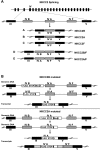Isoforms of renal Na-K-2Cl cotransporter NKCC2: expression and functional significance
- PMID: 18495801
- PMCID: PMC2576146
- DOI: 10.1152/ajprenal.00106.2008
Isoforms of renal Na-K-2Cl cotransporter NKCC2: expression and functional significance
Abstract
The renal Na-K-2Cl cotransporter (NKCC2, BSC1) is selectively expressed in the apical membrane of cells of the thick ascending limb of the loop of Henle (TAL) and macula densa. NKCC2-dependent salt transport constitutes the major apical entry pathway for transepithelial salt reabsorption in the TAL. Although NKCC2 is encoded by a single gene (Slc12a1), differential splicing of the NKCC2 pre-mRNA results in the formation of several alternate transcripts. Thus three full-length splice isoforms of NKCC2 differ in their variable exon 4, resulting in transcripts for NKCC2B, NKCC2A, and NKCC2F. In addition to full-length isoforms, variants with truncated COOH-terminal ends have been described. The various splice isoforms of NKCC2 differ in their localization along the TAL and in their transport characteristics. Data in the literature are reviewed to assess the principles of NKCC2 differential splicing, the localization of NKCC2 splice isoforms along the TAL in various species, and the functional characteristics of the splice isoforms. In addition, we discuss the functional significance of NKCC2 isoforms for TAL salt retrieval and for the specific salt sensor function of macula densa cells based on studies using isoform-specific NKCC2-knockout mice. We suggest that different NKCC2 splice variants cooperate in salt retrieval along the TAL and that the coexpression of two splice variants (NKCC2B and NKCC2A) in the macula densa cells facilitates efficient salt sensing over wide ranges of fluctuating salt concentrations.
Figures




References
-
- Abuladze N, Song M, Pushkin A, Newman D, Lee I, Nicholas S, Kurtz I. Structural organization of the human NBC1 gene: kNBC1 is transcribed from an alternative promoter in intron 3. Gene 251: 109–122, 2000. - PubMed
-
- Bartter FC, Pronove P, Gill JR Jr, Maccardle RC. Hyperplasia of the juxtaglomerular complex with hyperaldosteronism and hypokalemic alkalosis. A new syndrome. Am J Med 33: 811–828, 1962. - PubMed
-
- Beck L, Markovich D. The mouse Na+-sulfate cotransporter gene Nas1. Cloning, tissue distribution, gene structure, chromosomal assignment, and transcriptional regulation by vitamin D. J Biol Chem 275: 11880–11890, 2000. - PubMed
-
- Bettinelli A, Bianchetti MG, Girardin E, Caringella A, Cecconi M, Appiani AC, Pavanello L, Gastaldi R, Isimbaldi C, Lama G. Use of calcium excretion values to distinguish two forms of primary renal tubular hypokalemic alkalosis: Bartter and Gitelman syndromes. J Pediatr 120: 38–43, 1992. - PubMed
-
- Bevensee MO, Schmitt BM, Choi I, Romero MF, Boron WF. An electrogenic Na+-HCO3− cotransporter (NBC) with a novel COOH-terminus, cloned from rat brain. Am J Physiol Cell Physiol 278: C1200–C1211, 2000. - PubMed
Publication types
MeSH terms
Substances
Grants and funding
LinkOut - more resources
Full Text Sources
Molecular Biology Databases
Miscellaneous

